It’s a late autumn night, and you make the brisk walk back to your car only to notice a gaping hole in your passenger side window. The change in your ashtray is gone, as is the backpack you’d left the front seat. What took a thief a few minutes, left you dealing with the consequences of one of the fastest growing crimes in Seattle.
“Auto prowls are really a crime of opportunity,” said Associative Director of Seattle University Public Safety, Craig Birklid. “It costs them nothing to take a window out and take that property.”
In parking garages across the city auto prowls and car thefts are on the rise, according to a post by the Capitol Hill Seattle Blog earlier this month. While the two terms—car theft and auto prowl—may seem interchangeable, they are actually different crimes. A car theft refers to the taking of a car itself, while an auto prowl refers to the act of breaking into a car for valuables left inside. The reason for an auto prowl or car theft is typically circumstantial. There is seldom one reason for crime, rather it is the culmination of many different factors and the presentation of an opportunity to take something at no cost.
In the past, car thefts and auto prowls have been prevalent on the Seattle University campus.
“We probably took five to 10 auto prowls a day,” Birklid said. Even in the past two years, car theft and auto prowls have been frequent, with six reports of car theft and 53 reports of auto prowls on campus in 2013 and 2014, according to Birklid. Sixteen of the 18 auto prowls in 2013 were reported in the Broadway and Murphy Garages. This year, three car thefts have occurred on campus—noticeably fewer than in previous years. The decline of car crimes on campus owes part of its success to the diligence of the student community, Birklid said.
Senior Devon Walker, whose car was broken into in late September on Cherry Street between 13th and 14th Streets, was lucky enough to have Public Safety officers nearby.
“They saw the guy and followed him, because he stole my backpack. It just had shoes in it—nothing important,” Walker said. “The guy dropped the backpack, and [Public Safety] picked it up.”
Walker said he was happy with how Public Safety dealt with the situation, especially considering that his car wasn’t even parked on campus.
“Anytime you’re in a big city, car theft is something you have to be worried about,” said sophomore Ricky Reyes.“It’s always in the back of my mind how easy it is for someone to walk on campus. At the same time, I don’t really know the steps Public Safety takes, so I put a certain amount of trust in them.”
Sophomore Arunima Roy expressed similar concerns about the safety of cars on campus.
“That’s definitely worrying because I do have a car here on campus,” Roy said. “I feel safe [because] we are provided garages and Public Safety.”
Public Safety works diligently in conjunction with the Seattle Police Department in investigating car thefts and auto prowls around campus. Video evidence usually plays a large part in identifying possible suspects. While reports of car prowls and car thefts receive investigations, the success rate of finding lost or stolen items remains circumstantial.
“Occasionally we do get calls. Somebody will get their bookbag stolen from their car and we’ll get a call a few days later from someone in the neighborhood and they’ll have found it in their yard,” Birklid said.
Many perpetrators of these crimes often have prior experience in car theft and auto prowls, making them repeat offenders.
“Unfortunately, in the city of Seattle, auto prowling is so common that unless there are special circumstances, the SPD are not going to be able to do much in the way of investigation,” Birklid said.
Thieves primarily take electronics, GPS devices, laptops, cell phones and even loose change lying in cars. Fortunately, there are ways to minimize the risk of someone breaking into your car. Removing valuables from the car, keeping doors locked, not forgetting keys and being aware of surroundings are small steps that help minimize the risk of theft.
Birklid explained that there is no such thing as too much caution. More hands-on methods exist to minimize risk of theft, such as emptying drawers and glove boxes to display their emptiness. Keeping valuables in trunks and not leaving items unattended also help to negate much of the risk of car theft and auto prowling. Being aware of one’s environment and reporting loiterers to Public Safety can ensure community safety, Birklid said.
“We really depend upon our campus community and campus partners to notify us if they do see something that is wrong, so calling Public Safety if there’s a concern really helps,” Birklid said.
Editor may be reached at
news@su-spectator.com









